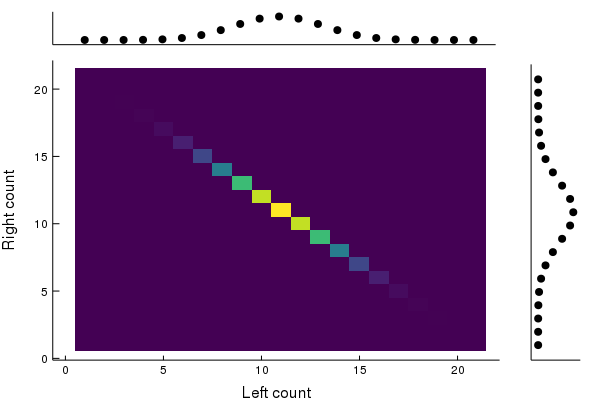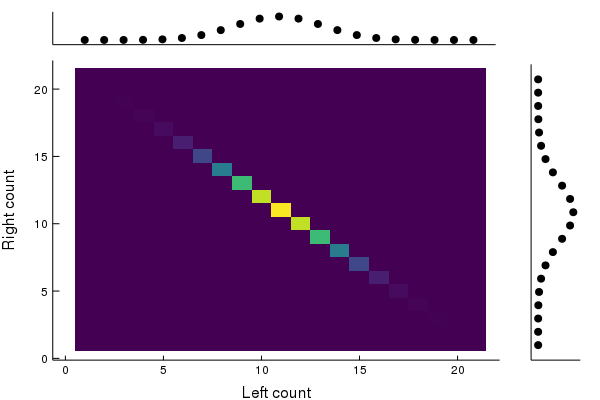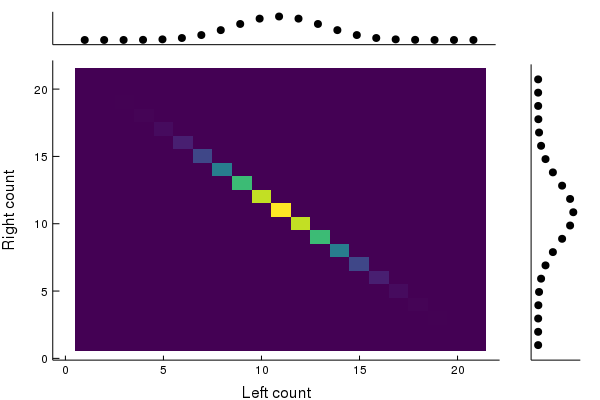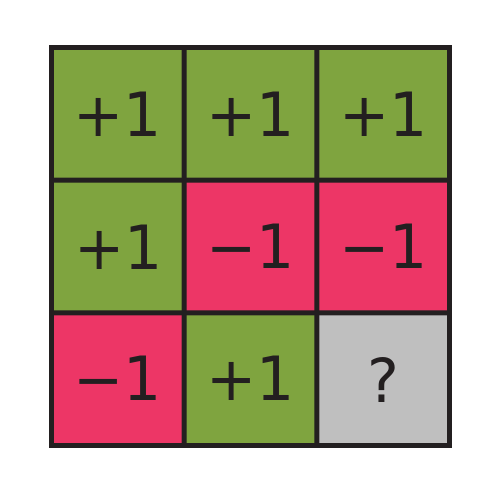When do we lose correlations under partial Markovian evolution?
Eric P. Hanson
March 21, 2019
Strategy
Classical analog: what kind of correlations are we talking about? How can we lose them?
What is entanglement?
(Briefly:) What quantum evolutions cause a complete loss of entanglement in finite time?
Ehrenfest model (classical)
At each time step, exactly one ball switches sides.
Coupled system
Well-known invariant distribution: π=2N1∑n=0N(nN)(δn⊗δN−n)
Perfectly correlated!
Loss to the environment
Loss of correlations! Becomes δ0⊗p for p=2N1∑n=0N(nN)δN−n.
Loss to the environment
Loss of correlations! Becomes δ0⊗p for p=2N1∑n=0N(nN)δN−n.
Alternate dynamics: Birth-death
At each timestep, prob. 101 for a ball to be born (until 20); prob. 101 for ball to die (until 0). Otherwise nothing happens.
Alternate dynamics: Birth-death
10 timesteps per frame, 600 total timesteps.
Loss of correlations! Asymptotically converges to u⊗p for u uniform.
More generally: irreducible + aperiodic
Initial joint distribution: π=2N1∑n=0N(nN)(δn⊗δN−n).
Let P be irreducible and aperiodic with invariant distribution q. Then π(Pk⊗id)=2N1n=0∑N(nN)((δnPk)⊗δN−n)→2N1n=0∑N(nN)(q⊗δN−n)=q⊗p
where p=2N1∑n=0N(nN)δN−n. Decouples!
But we don’t always lose correlations!
But we don’t always lose correlations!
Summary of the classical case
If we let one part of a joint system evolve independently, the two may decouple.

That decoupling can take infinitely long

Under periodic evolution, the joint system may not decouple.

Classical → quantum
- Probability distributions p∈Rd → quantum states ρ∈Md×d.
- pi≥0→ρ⪰0,
- ∑ipi=1→tr[ρ]=1.
- Markov transition matrix P → Φ linear, completely positive, trace-preserving map.
- P maps Rd to Rd → Φ maps Md×d to Md×d
- Joint distribution ∑iλipi⊗qi (convex combination of product distribution) → joint state ρ∈Md×d⊗Md×d.
- Key difference: it can be that ρ∈Md×d⊗Md×d cannot be expressed as ∑iλiρi⊗σi for ρi⪰0 and σi⪰0, and a probability distribution {λi}. Entanglement!
Entanglement
Entanglement is a non-classical correlation between the two systems. It is a bit of a strange type of correlation.
“No-signalling”; you can’t use entanglement alone to send messages
“Superdense coding” One can communicate 2n bits of classical information by only transmitting n bits of data, using n pre-shared “bits of entanglement” (n pairs of entangled qubits)
Which states are entangled?
3D cross section of two-qubit quantum states.
Green: all states.
Blue: classical states.
- Inside green, outside blue: entangled states
Avron, Joseph, and Oded Kenneth. 2019. “An Elementary Introduction to the Geometry of Quantum States with a Picture Book.” http://arxiv.org/abs/1901.06688.
What can you do with entanglement?
Magic square game
Task: Two isolated, cooperative players Alice and Bob try to construct a magic square
Rows must have an even number of −1’s
Columns must have an odd number of −1’s
Winning the game
Alice and Bob are judged probabilistically:
the referee asks Alice for one specific row, and Bob for one specific column (e.g. top row, second column)
Alice’s row must have an even number of −1’s, and Bob’s column an odd number, and they must agree on the intersection.
That’s it! They win or lose the game.
Classically, the best they can do is win 8/9 percent of the time
If they have access to pre-shared entanglement, they can win every time!

How do we lose quantum entanglement?
Classically…
If we let one part of a joint system evolve independently, the two may decouple.

That decoupling can take infinitely long

Under periodic evolution, the joint system may not decouple.

Irreducible + aperiodic quantum evolutions
Similar to property to the classical case: Φn(ρ)→σ for any ρ.
Just like in the classical case, this gives convergence of the joint state to a product state (here, σ⊗I/d where I/d is the identity matrix )
It turns out, product states of full support are in the interior of the set of separable states.
Then the convergence Φn(ρ)→σ gives that there is a finite time for any joint state to become separable under this evolution.
Which evolutions destroy all entanglement in finite time?
Irreducible + aperiodic
Direct sums thereof
Any map such that after some number iterations, it is a direct sum of irreduce + aperiodic maps.
That’s it!∗
∗: up to a faithfulness assumption, namely that there exists an invariant state with full support (possibly non-unique).
[Joint work with Cambyse Rouzé and Daniel Stilck França (https://arxiv.org/abs/1902.08173).]